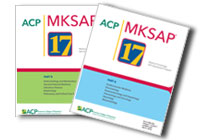Update your Knowledge with MKSAP 17 Q&A
 MKSAP has been trusted by internists since 1967 as the best resource for updating knowledge. MKSAP 17, available in Complete, Digital, and Print packages, consists of 11 comprehensive text chapters with related multiple-choice questions. You'll find 1,200 completely new questions to help you identify learning gaps, stay current, and gain the knowledge you need to provide the best possible patient care. MKSAP 17's original and high-quality questions evolve out of case studies and patient scenarios based on the latest evidence.
MKSAP has been trusted by internists since 1967 as the best resource for updating knowledge. MKSAP 17, available in Complete, Digital, and Print packages, consists of 11 comprehensive text chapters with related multiple-choice questions. You'll find 1,200 completely new questions to help you identify learning gaps, stay current, and gain the knowledge you need to provide the best possible patient care. MKSAP 17's original and high-quality questions evolve out of case studies and patient scenarios based on the latest evidence.
For more information on MKSAP 17, or to order your copy, visit mksap17.acponline.org.
MKSAP 17 Q & A
A 46-year-old man is evaluated for a 3-week history of right foot pain. The pain is located near the medial inferior heel without radiation. He describes the pain as sharp and occurring with the first few steps taken after awakening in the morning or after prolonged rest. The pain improves with continued walking. He reports no edema, erythema, or ecchymoses in this area, and he has no history of trauma. Medical history is significant for obesity. He has tried ibuprofen without pain relief.
On physical examination, vital signs are normal. BMI is 35. Strength and sensation in the foot are normal. There is pain on palpation of the medial tubercle of the calcaneus. Pain is also reproduced with passive dorsiflexion of the toes. Pain is not present on palpation of the posterior heel or with tapping inferior to the medial malleolus. There is no atrophy of the heel fat pad. Pes planus is present.
Which of the following is the most likely diagnosis?
A: Achilles tendinopathy
B: Heel pad syndrome
C: Plantar fasciitis
D: Stress fracture of the tarsal navicular bone
Click here for the answer and critique.

